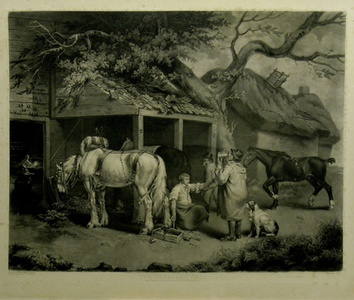| Method | Mezzotint |
| Artist | William Say after James Ward |
| Published | London Published May 20.1836, by the Engraver, No.92, Norton Street, Marylebone. |
| Dimensions | Image 460 x 605 mm, Plate 485 x 610 mm, Sheet 558 x 683 mm |
| Notes |
The British engraver and printmaker William Say (1768 - 1834), went to London in 1788, and studied under engraver and painter James Ward. In 1807, he engraved William Beechey's portraits of the Duke and Duchess of Gloucester, to whom he was then appointed engraver. Over his lifetime, Say produced a total of 335 plates, which included works after old masters as well as contemporary artists. Like Prince Rupert, Say was also a pioneer of mezzotint engraving, producing the first ever mezzotint on steel in around 1819. Say's son Frederic Richard Say was a successful portrait painter. The British artist James Ward (1769 - 1859) began his career as an engraver but had painterly aspirations. Influenced greatly by the work of George Morland and Peter Paul Rubens, Ward became the most sought after painter of animals of his day; painting mainly horses, as well as landscapes and genre scenes. His masterpiece is the monumental Gordale Scar (1812-14). Ward continued to be an exceptionally prolific artist throughout his long career but, in spite of this, his later years were plagued by financial difficulties. Lennox-Boyd i/i Ex. Col.: Hon. Christopher Lennox-Boyd Condition: Laid on board. |
| Framing | unmounted |
| Price | £475.00 |
| Stock ID | 29076 |

